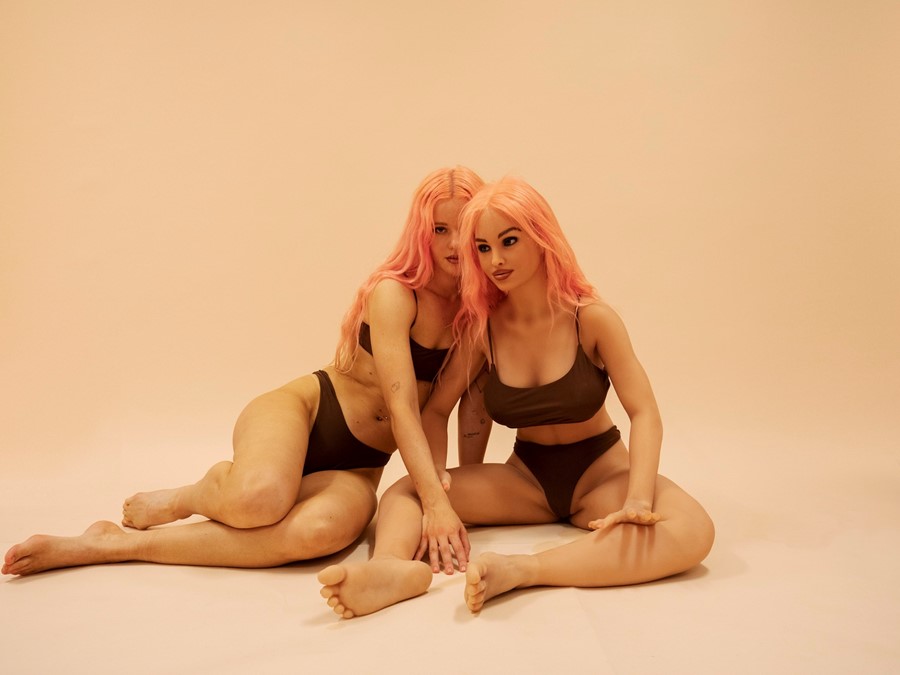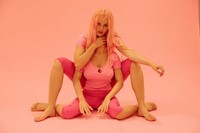As her new show opens in Sweden, the Stockholm-born artist talks about sexuality on the internet and why we will never live up to our perfect, digital clones
According to artist Arvida Byström, humans have an inferiority complex – and perhaps it’s justified. Our landscapes are becoming manufactured, our social and work lives gradually digitised, sex can be beckoned via apps on phones built by robots. “Machines are better than humans in a lot of fields,” explains Byström. “They are better than us at chess, in maths, they can compose beautiful classical music, create beautiful imagery.” A Doll’s House, a new exhibition from the Stockholm-born artist sees Byström photographed and filmed alongside Harmony, a silicone sex doll, and explores their bizarre sense of synonymity fostered by the digitisation of identity. A series of live performances also welcomes audience questions to the AI robot sex doll. Though sometimes headless, the figure is spray-tanned, with dyed hair to mimic Byström’s own appearance, creating an eerie, at times threatening effect.
Now age 30, the self-taught photographer spent much of her adolescent years online, curating found media mixed with her own self-portraits on a Tumblr blog. On public forums such as these, perverse encounters are an inevitability; some users’ brazen commentary knows no boundaries behind the shield of a screen – anonymous or otherwise. “But I think a lot of semi-nude selfie-taking online today is very homosocial – a way for women to bond with other women,” says Byström, who counts selfies as part of her artistic oeuvre and identifies as queer. “I don’t mind people finding my photos hot, but I really don’t want them to share their sexual thoughts with me on photos of my body.” But Byström finds herself detached from the jpeg; instead, she likens selfies to ‘copies’ of oneself, to the similar effect of statues, paintings – and dolls, like Harmony.
While Gen-Z’s dependence on retouching apps such as Facetune shows their desire to be more beautiful, it’s the resulting comparisons between the “copy” and the self that wreak havoc on the ego. “Certain parts of this are frustrating and sad, and sometimes devastating when trying to meet the perfection machines and technology creates,” she adds, “but it is also interesting to see this as a humbling experience.” A generation digitally eclipsed by artificial creations of themselves, which come manufactured by themselves, speaks to Byström of the chilly reality of humanity’s flawed sense of superiority. “The myth of Pygmalion still feels very relevant even today – I think that shows we have always had a complicated relationship to the portrayal of humans. We are scared of them being more beautiful, being more perfect.”

In one of the images exhibited, Byström replicates Michelangelo’s famed Pietà. The sex doll takes the form of Jesus after his crucifixion, while the artist is the Virgin Mary, cradling the inanimate doll. “I wanted to play with the idea of who is helping who in the relationship of man-versus-machine. I also like the idea of humans being made in the image of god, and now humans are playing god by making machines look and act like us.” Her own admittedly “girly” style persists throughout the series and film in minimal pink and brown lingerie, and feels familiar in its bubblegum E-girl fashion, while commentary on a digital generation makes up a hefty part of the artist’s body of work. Her 2018 short film, Disembodied Daughter, examined the apparently soothing and caring feminine vocal tones of iPhone’s Siri and its existence in reality, while in her still lives she captures fruits and phones wearing sheer and frilly underwear.
Post-Tumblr, Byström’s primary medium is now Instagram, and despite incessant obstacles from the platform’s censorship guidelines, using her body as an expression of identity and sexuality remains key to her practice. “We sext. We send nudes. I think we will always enjoy the digital more when it is enhancing our lives instead of trying to replace something in our lives.” Oscillating between fear and function, the idea of enhancement is often a concluding point to the man-versus-machine debate; through recognising technology’s impossible standards, we work side-by-side with it to better humanity, instead of letting it replace us. “What if our creations surpass us? And in many ways they have. The truth is: humans are mediocre and that is a relief. What if we stopped trying to be superior, since it is a game we will always lose?”
A Doll’s House is showing at Galleri Format until September 11.






